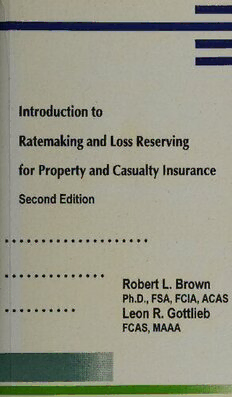
Introduction to Ratemaking and Loss Reserving for Property and Casualty Insurance PDF
Preview Introduction to Ratemaking and Loss Reserving for Property and Casualty Insurance
Introduction to _ Ratemaking and Loss Reserving for Property and Casualty Insurance Second Edition Robert L. Brown | Ph.D., FSA, FCIA, ACAS piece eccece Leon R.G ottlieb FCAS, MAAA Introduction to Ratemaking and Loss Reserving for Property and Casualty Insurance Second Edition Robert L. Brown, Ph.D., FSA, FCIA, ACAS Leon R. Gottlieb, FCAS, MAAA ACTEX Publications, Inc. Winsted, Connecticut Copyright © 2001, by ACTEX Publications, Inc. All rights reserved. No portion of this book may be reproduced in any form or by any means without the prior written permission of the copyright owner. Requests for permission should be addressed to: ACTEX Publications P.O. Box 974 Winsted, CT 06098 Manufactured in the United States of America 10987654321 Cover Design by MUF Library of Congress Cataloging-in-Publication Data Brown, Robert L., 1949- Introduction to ratemaking and loss reserving for property and casualty insurance / Robert L. Brown. p. cm. Includes index. ISBN 1-56698-394-0 1. Insurance, Property--United States--Rates and tables. 2. Insurance, Casualty--United States--Rates and tables. 3. Insurance--United States--Reserves. JI. Title. HG8065.B76 1993 368.1'011'0973--dc20 93-20279 CIP ISBN 1-59968-394-0 CONTENTS Preface vii Acknowledgements ix Preface to Second Edition xi CHAPTER ONE - Why Insurance? 1.1 The Evolution of Insurance 1 1.2 How Insurance Works 2 1.3. Insurance and Utility 3 1.4 What Makes a Risk Insurable 11 1.5 What Insurance Is and Is Not 13 1.6 Risk, Peril, and Hazard 14 1.7 Purchase of Insurance: Other Reasons 15 1.8 Exercises 16 CHAPTER TWO - Coverages on Introduction 21 22 Automobile Insurance 21 2.2.1 Liability Insurance 22 2.2.2 Medical Benefits 23 2.2.3 Uninsured and Under insured Motorist Coverage 25 2.2.4 Collision and Other Than Collision 26 23 Homeowners Insurance 28 2.4 Tenants Package 35 Z Workers Compensation 36 2.6 Fire Insurance 39 Dash Marine Insurance 40 2.8 Liability Insurance 41 2.9 Limits to Coverage 42 2.9.1 Deductibles 42 2.9.2 Policy Limits 44 2.10 Conclusion 45 2.11 Exercises 45 CHAPTER THREE - Ratemaking ig) Introduction 49 3.2 Objectives of Ratemaking 50 3.2.1 Essential Objectives 50 3.2.2 Non-Essential but Desirable Objectives 52 a3 Frequency and Severity 53 3.4 Data for Ratemaking 54 3.4.1 Accident Year 55 3.4.2 Policy Year 55 3.4.3 Calendar Year 56 3,0 The Exposure Unit 57 3.6 The Expected Effective Period 58 2 Ingredients of Ratemaking 60 3.7.1 Loss-Development Factors 60 3.7.2 Trend Factors 62 3.7.3 Expenses 67 3.7.4 Loading for Profit and Contingencies 68 3.7.5 Credibility Factors 69 3.7.6 Investment Income 71 3.8 Rate Changes 72 3.8.1 Overall Average Rate Change 72 3.8.2 Changing Risk Classification Differentials 79 3.8.3 Balancing Back 85 3.8.4 Summary of the Rate Change Procedure 88 39 Exercises 96 CHAPTER FOUR - Loss Reserving 4.1 Introduction 109 4.2 How Outstanding Benefits Arise 110 4.3 Definition of Terms 112 4.3.1 Individual Claim File Estimates 112 4.3.2 Gross IBNR 113 4.3.3 Paid Loss Development 113 4.3.4 Incurred Loss Development 114 4.3.5 Salvage and Subrogation 114 4.3.6 Loss Adjustment Expenses 114 4.3.7 Fast Track Reserves 115 4.4 Professional Considerations 115 4.5 Checking the Data 117 4.6 Loss Reserving Methods 118 4.6.1 Case Reserves Plus 118 4.6.2 The Expected Loss Ratio Method 118 4.6.3 The Chain-Ladder or Loss-Development Triangle Method 120 4.6.4 The Bornhuetter-Ferguson Method 132 vi 4.6.5 Estimates Split into Frequency and Severity 136 4.6.6 Summary 140 4.7 Discounting Loss Reserves 141 4.8 Exercises 144 CHAPTER FIVE - Intermediate Topics 5.1 Individual Risk Rating Plans 151 5.2 Increased Limits Factors 153 5.2.1 Data Considerations 153 5.2.2 Loss Development 155 5.2.3 Trend 156 5.2.4 Risk 158 5.2, Selexpensesa15$ 5.2.6 Loss Distributions 160 5.3 Reinsurance 161 5.3.1 Reserving for Reinsurance 167 5.4 Exercises 169 Appendix A 173 Answers to Text Exercises 177 Index 183 PREFACE The property/casualty area is one of the fastest growing practice areas in the actuarial profession. Because of this growth, there is a rapidly growing demand for good pedagogical material in the property/casualty discipline from university undergraduates, students in the early stages of writing actuarial exams, and actuaries employed in other practice areas who may have an interest in doing some property/ casualty work. This publication has evolved out of a set of course notes that I have used for nearly a decade to teach an introductory course in proper- ty/casualty insurance topics. The material can be covered comfortably in a twelve week teaching semester with time for review and problem classes. The material also represents the basic foundation of knowledge needed to gain an introductory appreciation of the building blocks of the property/casualty actuarial discipline. It is written from the perspective of one who first qualified as a Fellow of the Society of Actuaries, and then went on to achieve an Associateship in the Casualty Actuarial Society, and to work extensively in the property/casualty practice area in Canada. Very little background knowledge, either in mathematics or insurance, is required for a reading of this text, with one important exception. Section 1.3 on utility theory assumes a familiarity with calcu- lus and probability theory, including the concepts of random variables, density functions, expected values, and variances. In addition, the math- ematical topics of credibility, regression analysis, continuous growth models, and compound interest make brief appearances in the text. viii Although the material presented here is purely property/casualty in its origins, the application of the knowledge gained is much broader. The methods presented here have potential application not only in the property/casualty practice area, but also in accident and sickness insurance, group life and health insurance, and many other related areas. Students of this introductory material should not presume to have a working knowledge in the property/casualty practice area, how- ever. To achieve that, the interested reader is advised and encouraged to pursue the broader base of material available through the advanced syllabus of the Casualty Actuarial Society. This publication is meant to whet the appetite for more. To that extent, I invite you to partake and enjoy! Waterloo, Ontario Robert L. Brown March, 1993
